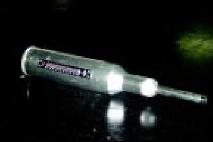REBOUND HAMMER
Rebound hammer test is done to find out the compressive strength of concrete by using rebound hammer as per IS: 13311 (Part 2) – 1992. The underlying principle of the rebound hammer test is
The rebound of an elastic mass depends on the hardness of the surface against which its mass strikes. When the plunger of the rebound hammer is pressed against the surface of the concrete, the pring-controlled mass rebounds and the extent of such a rebound depends upon the surface hardness of the concrete. The surface hardness and therefore the rebound is taken to be related to the compressive strength of the concrete. The rebound value is read from a graduated scale and is designated as the rebound number or rebound index. The compressive strength can be read directly from the graph provided on the body of the hammer.
Procedure to determine strength of hardened concrete by rebound hammer.
i) Before commencement of a test, the rebound hammer should be tested against the test anvil, to get reliable results, for which the manufacturer of the rebound hammer indicates the range of readings on the anvil suitable for different types of rebound hammer.
ii) Apply light pressure on the plunger – it will release it from the locked position and allow it to extend to the ready position for the test.
iii) Press the plunger against the surface of the concrete, keeping the instrument perpendicular to the test surface. Apply a gradual increase in pressure until the hammer impacts. (Do not touch the button while depressing the plunger. Press the button after impact, in case it is not convenient to note the rebound reading in that position.)
iv) Take the average of about 15 readings.

Interpretation of Results
The rebound reading on the indicator scale has been calibrated by the manufacturer of the rebound hammer for horizontal impact, that is, on a vertical surface, to indicate the compressive strength. When used in any other position, appropriate correction as given by the manufacturer is to be taken into account.
You can have the complete details of Non destructive Test by rebound hammer test here
If you have a query, you can ask a question here.



Can u plz tell me the site surveyin procedure include the instrument& their set up ?
sir, please send the procedure how to calculate the rebound test hammer result?? what’s mean of cube compressive strength as a function of the rebound number R??
sir, i want to known how to calculate the compression test with use 2 cube,…???
in delhi any option u have ?
sir,please send me the procedure how to calculate the rebound test hammer concrete result? and what’s is meaning of cube compressive strength as a function of the rebound R? best regard and thanks
Aris,
You need to calibrate the hammer on your own concrete. There are a number of curves available that can be used “off the shelf” but these are unlikely to give a good estimate. I am researching this at the moment and, so far, I am finding a good relationship between the Q Value (SilverSchmidt) and cube strength. In fact, the Q value on the concrete I am examining is not far from the strength …. but that is only on my concrete, which is a flint gravel mix. I will be doing more.
Thank you I have got what I want.
dear Sir
apart from Rebound Hammer Test, what are the other test that can be perfomed during investigation of cracks in different building elements (column,wall,stairs as well as foundation)!
dear sir,
can u tell us what is the important of this test?
what is the disadvantages of rebound hammer test
sir what is the meaning of avg of 15 reading i can t understand that line plz explain sir
sir,
on what principal work it ? what is procedure. how we interlink readings,apart from Rebound Hammer Test, what are the other test that can be perfomed during investigation of cracks in different building elements (column,wall,stairs as well as foundation)!
sir, please send the procedure how to calculate the rebound test hammer result?? what’s mean of cube compressive strength as a function of the rebound number R??
sir, what are the advantages and disadvantages of using the rebound hammer test?
i got rebound hammer test for d first time at my work site and the average reading was 30. the concrete v prepared was m25 and i used a 43 grade opc cement…so i jst wanted to confirm if tat 30 average reading is gud enuff or not??
sir, please send the procedure how to calculate the rebound test hammer result?? what’s mean of cube compressive strength as a function of the rebound number R??
Dear Sir/madam
We prepared the proportion for open drain was M20 concrete and we used 43 grade OPC cement for the work. how much average N/mm2 Strength we need to achive the M20 strength
WHETHER WE WILL CARRYOUT REBOUND HAMMER TEST, WHEN THE SURFACE IS IN WET CONDITION. 2NDLY IN RAINY DAY SHALL WE ABLE TO THE SAME. PLS INFORM ME.
SIR,
Please send the procedure on how to calculate the rebound hammer result obtained at site to get the concrete strength result. and BS specifications on various concrete strength.
list theNABL accredited labs for rebound hammer test
p>sir, please send the procedure how to calculate the rebound test hammer result?? what’s mean of cube compressive strength as a function of the rebound number R??